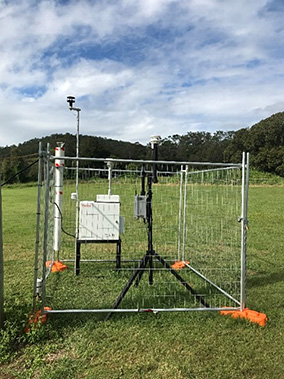Oxenford air quality monitoring project
In late 2019, community members reported concerns about environmental and health impacts of dust in Oxenford.
As a result, the Department of Environment, Science and Innovation (the department) commenced an investigation into air quality to identify potential risks to the community.
Quarry operators in the area provided their dust monitoring data. The department reviewed this data and found no evidence of environmental or health risk to the neighbouring community.
The department recognised that community members were still concerned about potential health impacts. To respond to these concerns, the department launched its own 14-month air quality monitoring project, commencing in April 2020.
Air quality monitoring methodology
The department undertook four types of monitoring at Oxenford:
- dust deposition (dust nuisance)
- respirable crystalline silica (RCS)
- real-time monitoring (RTM) of particulate emissions
- airborne asbestos.
The department worked with its air quality specialists to carefully select monitoring locations. Locations were determined to try and understand the exposure to the community from potential sources.
Dust deposition
The department collected dust samples and sent these to a laboratory for independent analysis. This analysis provides the department with information about dust composition, which can be used to help identify the source of the dust. See interim results .
Respirable crystalline silica (RCS)
The department installed monitoring equipment to measure the amount of crystalline silica in the air. Air standards are based on an annual average, so instrumentation was in place for 12 months. See interim results .
Real-time monitoring (RTM)
The department ran a trial to collect air quality data in real time between April and September 2020. Results of this trial provided indicative results of local air quality during this period along with wind direction data. This information was used to determine any short-term changes in air quality at the monitoring site in real time. See results from the real-time monitoring trial .
Airborne asbestos
The department conducted monitoring for asbestos in May and June 2021 to investigate the potential release of asbestos from quarrying activities in Oxenford. Monitoring was conducted downwind of blasting and crushing activities to determine any potential asbestos-related health risk with results to be compared to Safe Work Australia exposure limits.

How long was the monitoring conducted?
The department collected dust deposition and RCS data for 12 months (April 2020 – April 2021). A 12-month study allows us to see any seasonal variations in air quality.
Air quality monitoring results
The results of the monitoring project are now available in the Oxenford Air Monitoring Investigation Report.
This report was prepared by the Air Quality Monitoring Unit of the Department of Environment, Science and Innovation. Queensland Health was engaged to review and provide comment to ensure community concerns relating to potential health impacts were adequately addressed by the monitoring of RCS and airborne asbestos.
The results from the Oxenford investigation for the monitoring period showed no evidence that dust emissions from the Oxenford quarry, operated by Nucrush Pty Ltd were a significant contributor of RCS nor nuisance dust in the surrounding community. Monitoring for airborne asbestos during two blasting events resulted in no asbestos fibres being detected at any of the monitoring locations.
No evidence was found that dust emissions originating from the direction of the Oxenford quarry exceeded relevant objectives for the protection of human health. The monitoring results did not exceed the Queensland Environmental Protection (Air) Policy 2019 objectives for protection of human health, the Victorian Environment Protection Authority criterion for PM2.5 crystalline silica, or the Air Impacts Guideline criterion (Environmental Protection Act 1994) for dust nuisance.
Further information and resources
Learn more about the project in the Frequently asked questions.
Review a summary of the Oxenford Air Monitoring Investigation Report .
Access the Q&A detailing questions raised by the Oxenford community and the responses provided.
Report environmental nuisance
Community reports play a vital role in helping the department respond to, and investigate, the source of an issue in a timely manner.
You can report environmental nuisance (e.g. noise, dust, odour) using one of the options below:
- Online—submit an Environmental report
- Phone—call 1300 130 372 (option 2)—24 hours a day, 7 days a week
- Email—pollutionhotline@des.qld.gov.au providing as much information as possible.
Related information
Detailed air quality monitoring data is also available from the following sources:
- Queensland Government live air quality data service—provides continuous PM10, sulfur dioxide and heavy metals monitoring data and is updated hourly.
- Monthly air quality bulletins—provides continuous and daily (one day in six days) total suspended particulates (including metal content) data. The bulletins are available two months after the end of the reporting month.
- Queensland Government’s Open Data portal.


